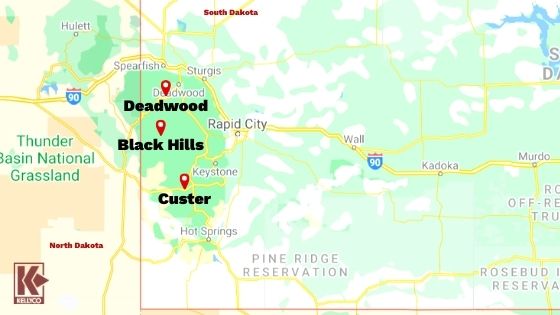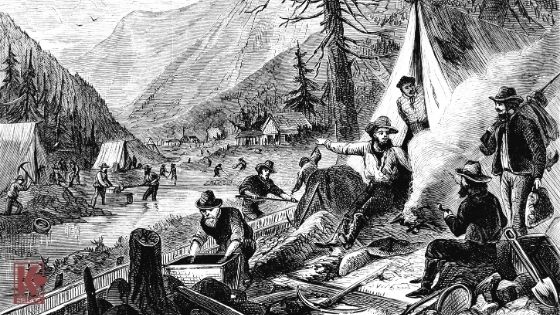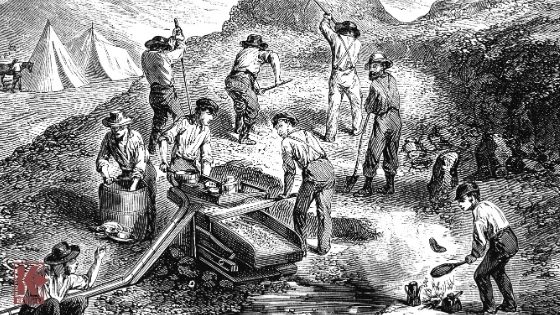The Black Hills Gold Rush
Published by Sam Jacobs on 08/31/20
Fans of the television series Deadwood will be somewhat familiar with the Black Hills Gold Rush. It is this gold rush that forms the background of the television series. Indeed, it is one of the more transformative events in American history, despite being somewhat lesser-known.
There were rumors of gold in the Black Hills region in the early years of the 19th Century. Sioux Indians were rumored to have been mining gold in the region as early as 1860. However, there was one small thing preventing Americans from mining gold in the region: the Treaty of Fort Laramie, which recognized the land as belonging to the Sioux.

The Black Hills
There is another point of law that is relevant to the Black Hills Gold Rush: The General Mining Act of 1872. This allows Americans to mine for minerals anywhere on federal land. The problem, for American prospectors, is that none of the land in the Black Hills was federal land — it belonged to the Sioux.
Americans Find Gold on Indian Land
In 1874, a deposit was found near present-day Custer, South Dakota. However, these were small deposits. Larger ones were found in November 1875. It was in 1876 that prospectors began to flood the region in violation of the treaty with the Sioux. To make matters worse, this wasn’t just any land to the Sioux — the Black Hills were considered sacred.
The first significant arrivals to the region were a force of 1,000 men led by George Armstrong Custer. They were investigating claims of gold in the region which, again, was in violation of the treaty. Small amounts were found, but the troop kept scouting, looking for larger deposits. The South Dakota towns of Hill City, Sheridan, and Pactola were founded by this detachment. Gold flakes were found along the way, but nothing that seemed to justify the expedition.
It was in the Northern Black Hills that paydirt was finally struck. This is the area of Deadwood and Whitewood Creeks. When the prospectors first arrived on the scene, gold was being scooped out by the spadeful with virtually no effort at all. The easily found gold is something known as “placer gold.” This had eroded for larger, harder deposits.
All of the land was quickly claimed, but thousands more settled the region hoping to find their fortune in gold nonetheless. All told, over 10 percent of the gold mined in the next 125 years was found in the initial Deadwood bonanza.
How the Black Hills Gold Rush Changed American History

American History
More than just economically, the Black Hills Gold Rush changed the makeup of the United States of America. A large section of the country that had been given to the Sioux was annexed to the United States. While it’s likely that this would have happened eventually anyway — it did everywhere else — the Black Hills Gold Rush provided an incentive for it to happen earlier.
It also made economic dynasties in the United States. For example, fans of Deadwood know that George Hearst is one of the primary antagonists of the series. He, in fact, was part of a consortium of developers who were instrumental in developing and expanding the Homestake Mine.
The Homestake Mine is an excellent way of conceptualizing the entire Black Hills Gold Rush. Discovered by Fred and Moses Manuel, Alex Engh, and Hank Harney in April 1876, these prospectors sold the claim to George Hearst, Lloyd Tevis, and James Ben Ali Haggin for the price of $70,000 in 1877. When the mine was discovered the land legally belonged to the Lakota Nation under the Treaty of Fort Laramie.
Of course, native treaties with the United States were always subject to the whims and vagaries of the United States government and this one was no exception to that rule. It was the desire of the United States to control the gold in the region that sparked off the Great Sioux War, sometimes known as the Black Hills War. This was the last major military operation against the native population of North America by the United States government.
The Great Sioux War

The Great Sioux War
Many people know of the Battle of Little Bighorn, General George Custer, Crazy Horse, and Sitting Bull. These are all firmly in the American lexicon as parts of our national mythos. But few know that they relate to the massive infusion of gold that came out of the Black Hills Gold Rush.
It is worth noting — as it often is — that the land that was being occupied by the Sioux at the time of the Great Sioux War was land that had previously belonged to other Indian tribes. In this case, it was the Kiowa, who were pushed out by the Sioux and their allies the Cheyenne and Arapaho. The resources the native tribes sought were not gold, but the rich buffalo hunting grounds that lay in the region.
For their part, the Cheyenne were one of the most centralized tribal groups on the Great Plains. This is ironic, considering that there were so many different American and European names for them, that the United States military were unaware that they were a single cohesive group for quite some time. It was the Northern Cheyenne who began attacks against white men in the area, but the United States government would not provide any protection — only select government officials had the right to be there. The United States was not going to use its military might to stop interlopers and glory hunters from getting killed by the rightful inhabitants of the region.
At least not yet.
The Black Hills Expedition AKA The Custer Expedition

The Custer Expedition
The Black Hills Expedition, also known as the Custer Expedition, was dispatched by the federal government in 1874. This was where significant amounts of gold were discovered and before the detachment had even returned to Fort Abraham Lincoln, news had spread across the nation of the gold. What’s more, the Lakota Indians in the region could see the writing on the wall and were taking on a defensive posture.
Just before the Black Hills Gold Rush began, there was the Panic of 1873. This began what was then known as the Great Depression, but what is now known as the Long Depression. Both individual prospectors and organized groups were moving into the region in violation of the Treaty of Fort Laramie.
It was easy enough to evade the United States Army detachments that were nominally patrolling the region and the Army did evict miners where it was able to do so. But without drones and other high-tech equipment to monitor the situation, the Army was at a disadvantage. Spotted Tail, Red Cloud, and Lone Horn headed a Sioux delegation to Washington, D.C. to convince President Ulysses S. Grant to enforce the treaty and stop the flow of miners. The government responded by offering $25,000 for the land and offering to relocate the Indians to Indian Country, in present-day Oklahoma.
The breakdown in negotiations was thanks to two main factors: First, a lot of bad blood between the Americans and the native tribes thanks to a slew of broken treaties. Second, the sacred nature of the Black Hills to the Indians. There had also been other encroachments into territories ostensibly belonging to the Sioux, generally by railroad interests. By 1876 the situation had broken out into total war. On February 28, 1877, the land was annexed by the victorious United States government.
The Homestake Mine: An American Treasure Trove

An American Treasure
The Homestake Mine was so laden with gold that it was mined until 2002. It was the largest and deepest mine ever found in North America. All told, there were 40 million troy ounces of gold mined out of the Homestake Mine during its lifetime.
George Hearst took active control of the Homestake Mine when he arrived in Deadwood in October 1877. With the arrival of Hearst, the mine became a much more industrial operation. He hauled in mining equipment from Sidney, Nebraska, which is 273 miles away.
Arthur De Wint Foote was brought in as an engineer. He himself is an excellent example of the pioneer spirit of the age. In 1873, he left Connecticut and set out for California in search of excitement, adventure, and, above all, gainful employment. He bounced around a number of jobs there in the railroads and civil engineering projects. In 1876, he went back east to get married to American author and illustrator Mary Hallock Foote, an important contemporary documentarian of the American West. It was after his marriage that he moved his new family to the town of Deadwood to oversee the Homestake Mine for George Hearst. After this, he headed south to Leaden, Colorado to oversee a silver mine there. Indeed, any story of American mining and gold prospecting during the time period will likely find Foote popping up.
In 1879, the mine went public with shares being listed on the New York Stock Exchange. The shares were listed until 2001, making it one of the longest listed stocks in the history of the exchange.
Those who have watched Deadwood know that Hearst is alleged to have used means fair and foul to grow and consolidate the mining in and around Homestake. Of course, the television series is fictional, but there is some truth to his villainous portrayal on the show. Some claims were purchased, others were poached in court. In one instance, a Hearst employee killed a prospector who refused to sell his claim. The man was acquitted in court after all of the witnesses disappeared. An anti-Hearst newspaperman was attacked on the street.
For his part, Hearst feared for his own safety and drafted a letter to his partners asking them to provide for his family in the event that he was bushwhacked. However, in three years Hearst left a very rich man, having consolidated most of the mining in the region under his control — a grand total of 30 acres of claims under his belt. By 1900, the Homestake Mine had expanded to include 300 claims sitting on 2000 acres. Mules and horses were finally replaced with fully operated machine equipment by the 1920s. All gold was shipped to the Denver mint.

Prospecting Gold
The gold ore at the mine wasn’t actually very good. It didn’t even yield an ounce of pure gold for every ton of ore mined. The reason the mine was such a bonanza was because of the size of the discovery, not because of its quality. The size made the low quality of the ore, not a problem. In addition to the gold, the mine produced 9 million troy ounces of silver. A combination of the aforementioned poor ore quality, low gold prices, and high production costs put the mine out of business in 2001, another American icon lost to the changing times and changing markets.
The mine is now run by the National Science Foundation. It was planned to be used as a deep underground research mine. Maintenance of the mine cost a quarter-million dollars every day, so it was quickly shut down as a deal to transfer ownership became mired in the weeds. It was finally selected by the National Science Foundation for the Deep Underground Science and Engineering Laboratory (DUSEL) in 2007. In June 2009 the University of California Berkeley announced that it would begin to operate the mine for research on neutrinos and dark matter particles.
A somewhat obscure problem in nuclear physics was discovered at the mine in the 1960s, the solar neutrino problem. The problem itself is a little above our pay grade but the important part is that it came out of an experiment performed at the mine and was not resolved until 2002. Those with a mind for theoretical physics will know this as the Homestake experiment.
While not cutting the imposing and impressive posture of Mount Rushmore, which sits in the Black Hills, the Homestake Mine is arguably a more important part of American history. After all, a monument is simply an engineering project, whereas the Homestake Mine carved a Mount Rushmore-sized place into the social fabric of America through the jobs and the gold that it provided. It will continue to be a source of American historical developments as a place for our nation’s top scientists to conduct experiments.
`